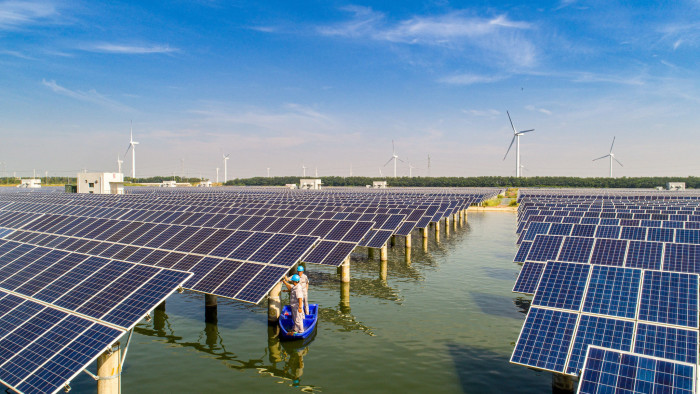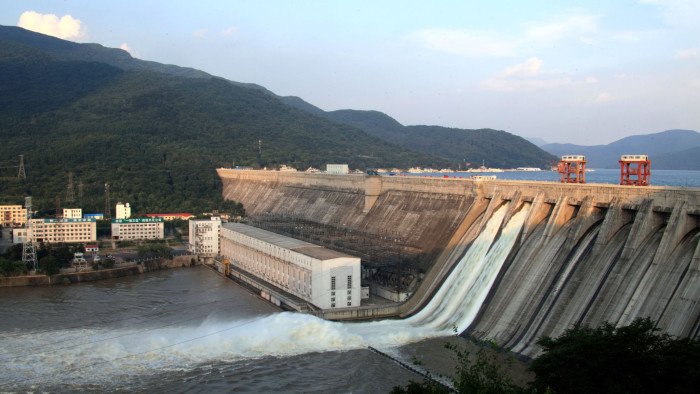Global investors prepare to brave China’s green bond minefield

Roula Khalaf, Editor of the FT, selects her favourite stories in this weekly newsletter.
Some of the proceeds go to wind projects. Some help build new coal power plants. And lots of cash raised in Chinese green bond deals simply adds to state-owned companies’ working capital.
China’s domestic green bond market has been a minefield for global investors, who worry they might inadvertently buy green debt that does not meet international standards.
But the growth of the Chinese market in recent years has been too fast for the world’s largest investors to ignore, and many experts say standards are improving.
“What I’ve seen is the rapid growth of the market but a slight increase in harmonisation with international standards,” says Xuan Sheng Ou Yong, a green bond analyst at BNP Paribas Asset Management in Hong Kong.
Chinese companies led the world in green bond issuance last year, when they sold $33.6bn worth, according to data group Dealogic. The country’s rise to the forefront of the market has been rapid, expanding from three green bond deals worth $1.2bn in 2015 to 43 worth $33.2bn the following year.
Green finance is an area of focus for many of the world’s largest asset managers and pension funds. Such investors have created “environmental, social and governance” (ESG) frameworks that guide how they invest and ensure they are not creating unacceptable levels of pollution or disruption to local communities.
The promise of a green bond is that its proceeds will go to environmentally friendly uses such as wind farms, solar projects or hydropower.

Several global organisations have issued guidelines for green finance standards. The International Capital Market Association (ICMA), for example, issues the Green Bond Principles, which are used as a cornerstone for global standards.
But China’s domestic market, in which most of its green bonds are issued, is still far from meeting such standards, meaning that most of the world’s largest and fastest-growing green bond market is off-limits to foreign investors.
“Despite its relatively large size, we believe global green bond investors are not involved in China’s domestic renminbi-denominated green bond market,” says Singapore-based Paul Lukaszewski, Aberdeen Standard Investments’ head of corporate debt for Asia and Australia.
“The variety of local standards and their divergence from internationally recognised frameworks, such as the Green Bond Principles or the Climate Bonds Initiative, require global investors to do more diligence to verify whether the use of proceeds are targeted at green projects.”
In China’s onshore market, companies’ claims of greenness are often suspect. Local rules allow certain types of companies to use some proceeds as working capital — something that does not qualify for most global investors.
Several types of green projects in China look brown to western fund managers. For example, the retrofitting of fossil fuel boilers to make them more efficient is considered green in China but not overseas. Upgrades to the coal industry such as carbon capture and coal washing — “clean coal” technologies — have long been made using green bonds in China but not elsewhere.
In some cases, companies have been accused of “greenwashing” — purposefully making it appear the debt will be used for environmentally friendly matters but investing in projects that do not meet those standards.
Yet there are also signs that Chinese bond issuers are learning how to live up to global standards. The percentage of offshore green bonds denominated in currencies other than the renminbi has increased over the past four years. Those securities have been forced to reach global standards in order to attract investors.
“Almost all Chinese green bond issuance in the offshore market follows the Green Bond Principles — so international investors can have confidence that the use of proceeds and the disclosure are in line with international best practice,” says Mushtaq Kapasi, the ICMA’s chief representative for the Asia-Pacific region.
Renminbi-denominated debt, he says, is a different story. “In the onshore Chinese market, the regulations and taxonomies in place right now can allow for projects that might not fit in with the requirements of investors outside China looking for sustainability.”
Despite the challenges, there are signs that China’s onshore market could become more accessible for global investors. Last week, China’s central bank proposed excluding “clean coal” projects from qualifying for green bonds funding — a major step in aligning with global standards. Some experts also say Chinese financial disclosure is improving, although it is yet to reach global standards.
Awareness of and demand for green bonds among Chinese investors is also increasing as some companies adopt ESG frameworks. As more Chinese investors come to understand the green bond market, the trading environment for the securities will improve, experts say — a vital factor for global investors who want a liquid market.
“In China, the awareness on ESG and green investment is somewhat behind for asset owners,” says Nan Luo, head of China at the UN-backed Principles for Responsible Investment group. “But there are signs they are stepping up.”

Comments